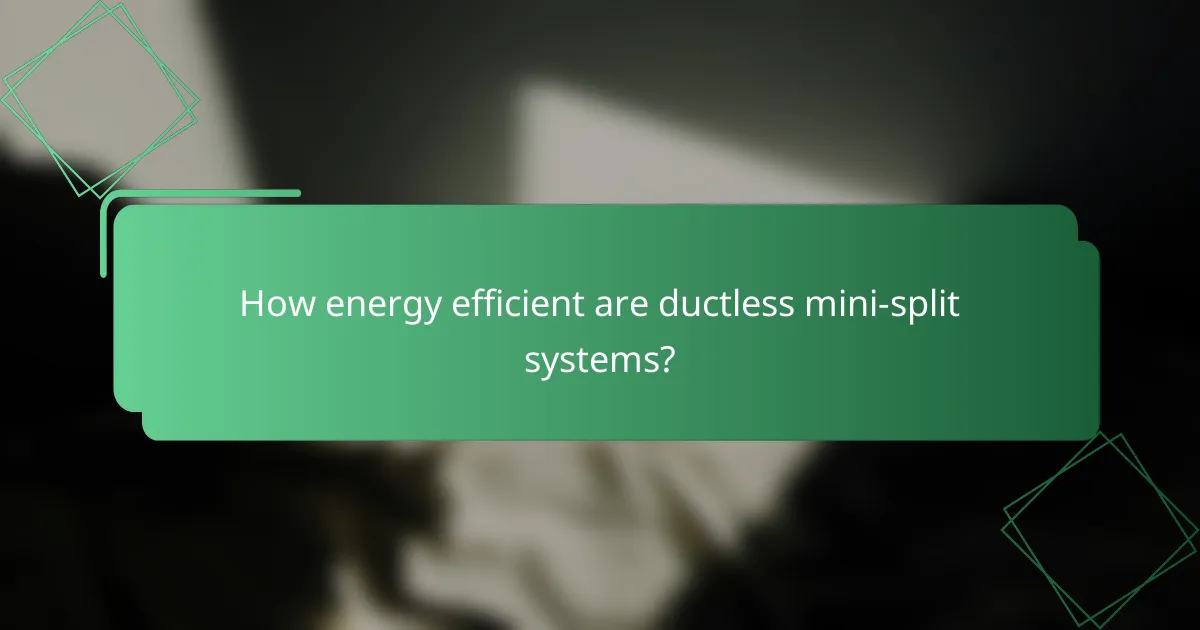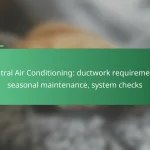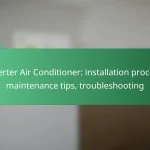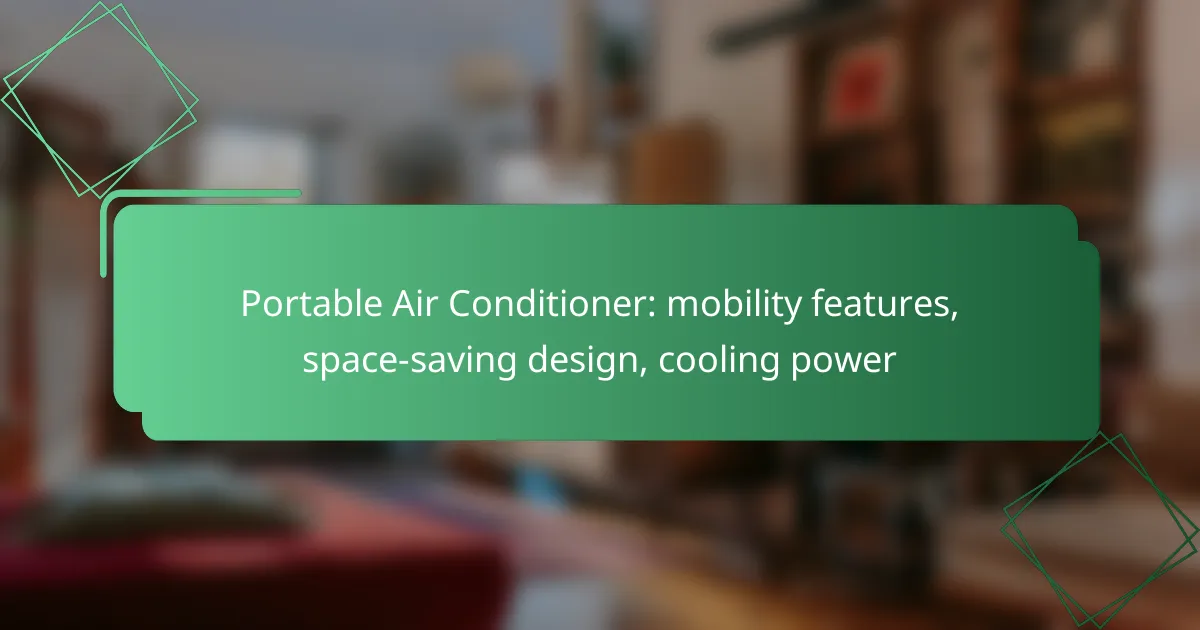Ductless mini-split systems provide exceptional energy efficiency, often boasting SEER ratings that outpace conventional HVAC units. Their flexible installation options, including wall, ceiling, and floor-mounted units, cater to diverse space needs, while their quiet operation enhances comfort in both residential and commercial settings.

How energy efficient are ductless mini-split systems?
Ductless mini-split systems are highly energy efficient, often featuring Seasonal Energy Efficiency Ratio (SEER) ratings that significantly surpass traditional HVAC systems. Their design allows for targeted heating and cooling, which contributes to lower energy consumption and reduced utility bills.
High SEER ratings
Ductless mini-split systems typically boast SEER ratings ranging from the mid-teens to over 30, making them a superior choice for energy efficiency. A higher SEER rating indicates better energy performance, meaning these systems use less electricity to provide the same amount of cooling or heating compared to lower-rated units.
When selecting a mini-split system, look for models with SEER ratings of 20 or higher for optimal energy savings. This can result in significant reductions in your monthly energy bills, especially in climates with extreme temperatures.
Reduced energy consumption
These systems operate by directly cooling or heating specific zones, which minimizes energy waste associated with ductwork. Unlike traditional systems that condition the entire home, ductless mini-splits allow you to control temperatures in individual rooms, leading to lower overall energy consumption.
Additionally, many mini-split systems utilize inverter technology, which adjusts the compressor speed based on the current temperature needs. This feature not only enhances comfort but also contributes to further energy savings by avoiding the energy spikes associated with traditional on/off systems.
Cost savings over time
Investing in a ductless mini-split system can lead to substantial cost savings over time due to their energy efficiency. While the initial installation cost may be higher than traditional systems, the reduced energy bills can offset this expense within a few years.
Homeowners can expect to save anywhere from 20% to 50% on heating and cooling costs compared to conventional systems. Moreover, many utility companies offer rebates or incentives for installing energy-efficient systems, which can further enhance your savings.

What installation options are available for ductless mini-splits?
Ductless mini-splits offer versatile installation options that cater to various space requirements and preferences. Homeowners can choose from wall-mounted, ceiling-mounted, or floor-mounted units, each providing unique benefits and considerations.
Wall-mounted units
Wall-mounted units are the most common type of ductless mini-split installation. They are typically placed high on a wall, allowing for efficient air distribution throughout the room. This option is ideal for spaces with limited floor space and can be installed in various locations, including living rooms and bedrooms.
When considering wall-mounted units, ensure that the chosen location allows for unobstructed airflow and easy access for maintenance. Installation usually involves mounting the indoor unit on the wall and connecting it to the outdoor compressor via refrigerant lines.
Ceiling-mounted units
Ceiling-mounted units are a great choice for larger spaces or rooms with high ceilings. These units can be recessed into the ceiling or hung below it, providing a sleek look while maximizing airflow. They are particularly effective in commercial settings or open-concept homes where air circulation is crucial.
Installation of ceiling-mounted units may require more extensive work, including ceiling modifications and additional support structures. However, they can distribute air evenly across a wide area, making them a practical option for larger environments.
Floor-mounted units
Floor-mounted units are designed to sit low to the ground, making them suitable for spaces with limited wall or ceiling options. These units can be placed against walls or in corners, providing flexibility in installation. They are often used in basements or areas where wall space is at a premium.
When opting for floor-mounted units, consider their proximity to furniture and other obstructions that may hinder airflow. Installation is generally straightforward, involving placement on the floor and connection to the outdoor unit, making them a practical choice for many homeowners.

How do ductless mini-splits compare in noise levels?
Ductless mini-splits are generally quieter than traditional HVAC systems, making them an appealing choice for residential and commercial spaces. Their design minimizes noise, allowing for a more comfortable environment.
Quiet operation
Ductless mini-splits operate at low noise levels, often ranging from 19 to 50 decibels, depending on the model and settings. This quiet operation is achieved through advanced technology that isolates the compressor and fan noise, making them suitable for bedrooms, offices, and other quiet areas.
Many models feature a “silent mode” that further reduces noise during operation, enhancing comfort without disturbing daily activities or sleep.
Decibel ratings
Decibel ratings for ductless mini-splits can vary significantly. Most indoor units operate between 19 to 30 decibels, which is comparable to a whisper or rustling leaves. Outdoor units may reach higher levels, typically between 50 to 60 decibels, similar to normal conversation.
When selecting a mini-split, consider both indoor and outdoor noise levels to ensure they meet your comfort needs, especially if the outdoor unit is close to living spaces.
Comparison with traditional HVAC systems
Traditional HVAC systems often operate at higher noise levels, typically ranging from 60 to 80 decibels. This can be disruptive, particularly in quiet environments. In contrast, ductless mini-splits provide a more serene experience, making them preferable for many homeowners.
Additionally, ductless systems eliminate the need for ductwork, which can amplify noise from air movement. This further enhances their appeal for those seeking a quieter heating and cooling solution.

What are the installation requirements for ductless mini-splits in the UK?
Ductless mini-splits in the UK require specific installation considerations, including electrical setup, space availability, and professional installation. Understanding these requirements ensures optimal performance and compliance with local regulations.
Electrical requirements
For ductless mini-splits, the electrical requirements typically include a dedicated circuit with a suitable amperage, often ranging from 15 to 30 amps depending on the unit’s capacity. It’s essential to ensure that the electrical supply can handle the load without overloading existing circuits.
Additionally, the installation must comply with UK wiring regulations, specifically the IET Wiring Regulations (BS 7671). This ensures safety and efficiency in the electrical setup.
Space considerations
Space requirements for ductless mini-splits involve both indoor and outdoor units. Indoor units should be installed in areas that allow for proper airflow and are away from obstructions, typically mounted high on walls or ceilings. Ensure at least a few inches of clearance around the unit for optimal performance.
Outdoor units need sufficient space for ventilation and maintenance access. A clear area of at least 30 cm around the unit is recommended to prevent overheating and ensure efficient operation.
Professional installation recommendations
Hiring a qualified professional for the installation of ductless mini-splits is highly recommended to ensure compliance with local regulations and optimal performance. Professionals can assess the specific needs of your space and recommend the best unit size and placement.
When selecting an installer, look for certified technicians with experience in ductless systems. This can help avoid common pitfalls, such as improper placement or inadequate electrical connections, which can lead to inefficiency or system failure.

What factors should you consider when choosing a ductless mini-split system?
When selecting a ductless mini-split system, consider size and capacity, brand reputation, and warranty and support. These factors significantly influence the system’s efficiency, reliability, and overall satisfaction with your investment.
Size and capacity
The size and capacity of a ductless mini-split system are crucial for optimal performance. Systems are rated in BTUs (British Thermal Units), and choosing the right capacity ensures efficient heating and cooling. Generally, a capacity of 12,000 to 36,000 BTUs is suitable for most residential spaces, but it’s essential to calculate your specific needs based on room size and insulation.
To determine the appropriate size, consider factors like ceiling height, number of windows, and local climate. An undersized unit may struggle to maintain comfort, while an oversized one can lead to increased energy costs and humidity issues.
Brand reputation
Brand reputation plays a significant role in the reliability and performance of ductless mini-split systems. Established brands often have a history of quality and customer satisfaction, which can provide peace of mind. Look for brands with positive reviews, industry awards, and a strong presence in the market.
Researching customer feedback and expert reviews can help you identify brands that consistently deliver high-quality products. Brands like Mitsubishi, Daikin, and Fujitsu are often recognized for their durability and energy efficiency.
Warranty and support
A robust warranty and reliable customer support are essential when choosing a ductless mini-split system. Warranties typically range from five to ten years, covering parts and sometimes labor. A longer warranty indicates the manufacturer’s confidence in their product and can save you money on repairs.
Additionally, consider the availability of customer support and service technicians in your area. A manufacturer with a strong support network can provide timely assistance and maintenance, ensuring your system operates efficiently over its lifespan.

What are the maintenance needs for ductless mini-split systems?
Ductless mini-split systems require regular maintenance to ensure optimal performance and longevity. Key maintenance tasks include cleaning filters, scheduling annual professional servicing, and addressing common issues promptly.
Regular filter cleaning
Cleaning the filters in your ductless mini-split system is essential for maintaining efficient airflow and indoor air quality. It’s recommended to clean the filters every month, especially during peak usage seasons. Simply remove the filters, rinse them with water, and let them dry before reinstalling.
Neglecting filter maintenance can lead to reduced efficiency and increased energy bills, as the system has to work harder to circulate air. Keeping filters clean can improve energy efficiency by up to 15%.
Annual professional servicing
Scheduling annual professional servicing is crucial for the long-term health of your ductless mini-split system. A qualified technician will inspect the system, clean the coils, check refrigerant levels, and ensure all components are functioning correctly. This service typically costs between $100 and $300, depending on your location and the complexity of the system.
Regular professional maintenance can help identify potential issues before they become costly repairs, ensuring your system operates efficiently year-round.
Common troubleshooting tips
If your ductless mini-split system is not performing as expected, there are a few common troubleshooting steps you can take. First, check the remote control batteries and ensure the settings are correct. If the system is not cooling or heating effectively, inspect the filters for dirt buildup.
Additionally, listen for unusual noises, which may indicate a mechanical issue. If problems persist after these checks, it’s advisable to contact a professional technician for further diagnosis and repair.










